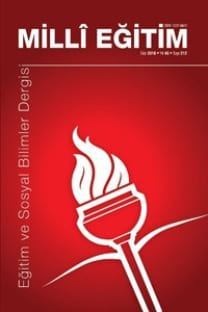İLKÖĞRETİM 8. SINIF MATEMATİK DERS KİTABININ EĞİTİMSEL TASARIMINA İLİŞKİN ÖĞRETMEN VE UZMAN GÖRÜŞLERİ
Bu araştırmada, ilköğretim 8. sınıf matematik ders kitabının eğitimseltasarımına yönelik öğretmen ve matematik eğitimcilerinin görüşlerini ortayakoymak amaçlanmıştır. Öğrenci merkezli yaklaşımları temele alan bir matematik ders kitabının, eğitimsel tasarımına yönelik literatürde yedi ana kategoritanımlanmıştır. Bu kategorileri temele alarak geliştirilmiş bir anket formuTrabzon’da 40 matematik öğretmenine uygulanmıştır. Üç matematik eğitimcisive bu öğretmenler arasından rastgele seçilen beş öğretmen ile ders kitabının bukategorilere uygunluğunu derinlemesine ortaya koymak amacıyla mülakatlaryapılmıştır. Elde edilen veriler, ders kitabının bu kategorileri orta düzeyde yansıttığını, “öğrenci fikirlerini dikkate alma” ve “matematik öğrenme ortamınıgeliştirme” kategorilerinde ise daha yetersiz olduğunu göstermiştir.Araştırmada, ders kitabında öğretim programının gereklerini yerine getirmekamacıyla çaba harcandığı, ancak çoğu kez bu çabanın geleneksel ve öğrenci merkezli yaklaşımlar arasında sıkışıp kaldığı sonucuna ulaşılmıştır. Bazı durumlarda öğretmen ve uzman görüşlerinin farklılaştığı görülmüştür. Bu temel kategoriler, öğretim programının temele aldığı öğrenci merkezli yaklaşımları yansıtacak bir ders kitabını geliştirmek veya değerlendirmek için kullanılabilir
TEACHER AND EXPERT VIEWS ON
EDUCATIONAL DESIGN OF 8th GRADE
MATHEMATICS TEXTBOOK
The purpose of this study is to determine teachers and mathematics educators’ views on the educational design of 8th grade mathematics textbook. Seven main categories for the educational design of the mathematics textbook based on the student-centered approaches is identified in literature. A survey that was developed based on these categories was applied 40 mathematics teachers in Trabzon. Also, the interviews were conducted with three mathematics educators and five teachers, randomly selected among the teachers, in order to determine the suitability of textbook to these categories in-depth. The findings of the study indicate that the textbook meets these categories at the intermediate level. However the categories of “taking into account students’ ideas” and “enhancing the mathematics learning environment” are weaker than the others. It is concluded that although efforts were made to meet the requirements of curriculum in the textbook, the efforts squashed into between traditional and students-centered approaches. In some cases, the opinions of teachers and educators became different. These categories are used to improve or evaluate a textbook which reflects the student-centered approaches of the curriculum.
